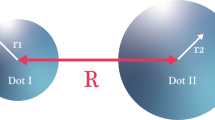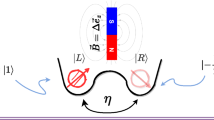Abstract
We analyze theoretically the Wigner function negativity for thermal density matrix of analogous and equidistant two coupled semiconductor quantum dots at different temperatures. In this respect, we explore the quantum influences of the temperature, the external electric field, the Förster interaction and the exciton-exciton dipole interaction energy on its behavior. In particular, we show that the negativity of wigner function still survives for large values of temperature ensuring that the non-classicality of the two coupled semiconductor quantum dots system does not get lost under thermal effect. Moreover, we show that this negativity is hypersensitive to the external electric field effect, nevertheless, its sensitivity to this effect is extensively perturbed for higher values of Förster interaction, temperature and exciton-exciton dipole interaction energy. Further, we show that increasing this latter enhances the quantumness of system as the negativity of wigner function also increases.


Similar content being viewed by others
Explore related subjects
Discover the latest articles, news and stories from top researchers in related subjects.References
Wigner, E.P.: On the quantum correction for thermodynamic equilibrium. Phys. Rev. 40, 749 (1932)
Kenfack, A., Zyczkowski, K.: Negativity of the Wigner function as an indicator of non-classicality. J. Opt. B: Quant. Semiclass. Opt. 6, 396 (2004)
Lee, K.F., Reil, F., Bali, S., Wax, A., Thomas, J.E.: Heterodyne measurement of Wigner distributions for classical optical fields. Opt. Lett. 24, 1370 (1999)
Mukamel, E., Banaszek, K., Walmsley, I.A., Dorrer, C.: Direct measurement of the spatial Wigner function with area-integrated detection. Opt. Lett. 28, 1317 (2003)
Smith, B.J., Killett, B., Raymer, M.G., Walmsley, I.A., Banaszek, K.: Measurement of the transverse spatial quantum state of light at the single-photon level. Opt. Lett. 30, 3365 (2005)
Szydłowski, D., Wołoszyn, M., Spisak, B.J.: Phase-space description of wave packet approach to electronic transport in nanoscale systems. Semicond. Sci. Technol. 28, 105022 (2013)
Benedict, G.M., Czirjk, A.: Wigner functions, squeezing properties, and slow decoherence of a mesoscopic superposition of two-level atoms. Phys. Rev. A 60, 4034 (1999)
Sadeghi, P., Khademi, S., Nasiri, S.: Nonclassicality indicator for the real phase-space distribution functions. Phys. Rev. A 82, 012102 (2010)
Siyouri, F.Z.: Comparative study of entanglement and wigner function for multi-qubit GHZ-Squeezed state. Commun. Theor. Phys. 68, 729 (2017)
Siyouri, F., El Baz, M., Hassouni, Y.: The negativity of Wigner function as a measure of quantum correlations. Quantum Inf. Proc. 15, 4237–4252 (2016)
Siyouri, F., El Baz, M., Hassouni, Y.: Role of Wigner function in studying quantum correlations. Int. J. Mod. Phys. B 30, 1650187 (2016)
Siyouri, F.Z.: Markovian and non-Markovian dynamics of non-classical correlations and Wigner function for GHZ-type coherent states. Int. J. Theor. Phys. 58(1), 103–113 (2019)
Simon, R.: Peres-Horodecki separability criterion for continuous variable systems. Phys. Rev. Lett. 84, 2726 (2000)
Taghiabadi, R., Akhtarshenas, S.J., Sarbishaei, M.: Revealing quantum correlation by negativity of the Wigner function. Quantum Inf. Proc. 15, 1999 (2016)
Mari, A., Eisert, J.: Positive Wigner functions render classical simulation of quantum computation efficient. Phys. Rev. Lett. 109, 230503 (2012)
Veitch, V., Wiebe, N., Ferrie, C., Emerson, J.: Efficient simulation scheme for a class of quantum optics experiments with non-negative Wigner representation. New J. Phys. 15, 013037 (2013)
Nazir, A., Brendon, W., Lovett, Sean D., Barrett, John H., Reina, G., Andrew, D.: Anticrossings in Förster coupled quantum dots. Briggs Phys. Rev. B 71, 045334 – Published 27 January (2005)
Shinkai, G., Hayashi, T., Ota, T., Fujisawa, T.: Correlated coherent oscillations in coupled semiconductor charge qubits. Phys. Rev. Lett. 103, 056802 (2009)
Chen, G., Bonadeo, N.H., Steel, D.G., Gammon, D., Katzer, D.S., Park, D., Sham, L.J.: Optically induced entanglement of excitons in a single quantum dot. Science 289, 1906 (2000)
Fanchini, F.F., Castelano, L.K., Caldeira, A.O.: Entanglement versus quantum discord in two coupled double quantum dots. New J. Phys. 12, 073009 (2010)
Shojaei, S., Mahdian, M., Yousefjani, R.: Electric field effects on quantum correlations in three coupled semiconductor quantum dots. Int. J. Quantum Inf. 11(01), 1350009 (2013)
Mansour, H. A., Siyouri, F. Z., Faqir, M., Baz, M. E.: Quantum Correlations Dynamics In Two Coupled Semiconductor InAs Quantum Dots. arXiv preprint arXiv:2003.01158 (2020)
Nielsen, M.A., Chuang, I.L.: Quantum Computation and Quantum Information. Cambridge University Press, Cambridge (2000)
Nishibayashi, K., Kawazoe, T., Ohtsu, M., Akahane, K., Yamamoto, N.: Observation of interdot energy transfer between inas quantum dots. Appl. Phys. Lett. 93, 042101 (2008)
Forster, T.: Intermolecular energy transfer and fluorescence. Ann. Phys. Leipzig. 6, 55–57 (1948)
Gerry, C., Knight, P.: Introductory Quantum Optics. Cambridge University Press, Cambridge (2005)
Dodonov, V.V.J.: Nonclassical’states in quantum optics: asqueezed’review of the first 75 years. Opt. B Quantum Semiclass Opt. 4, R1–R33 (2002)
Barenco, A., Deutsch, D., Ekert, A., Jozsa, R.: Conditional quantum dynamics and logic gates. Phys. Rev. Lett 74, 4083 (1995)
He-jun, W., Fan, H.: Two-mode Wigner operator in \(\left\langle \eta \right| representation\). Mod. Phys. Lett. B 11, 544 (1997)
Jiang, N.Q.: The n-partite entangled Wigner operator and its applications in Wigner function. J. Opt. B Quantum Semiclass Opt. 7, 264 (2005)
Author information
Authors and Affiliations
Corresponding author
Additional information
Publisher's Note
Springer Nature remains neutral with regard to jurisdictional claims in published maps and institutional affiliations.
Rights and permissions
About this article
Cite this article
Siyouri, FZ., Mansour, H.A. Robustness of Wigner function negativity under the exciton-exciton interaction effects inside two coupled semiconductor quantum dots. Quantum Inf Process 20, 136 (2021). https://doi.org/10.1007/s11128-021-03074-4
Received:
Accepted:
Published:
DOI: https://doi.org/10.1007/s11128-021-03074-4




